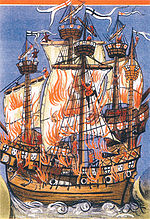- Battle of Saint-Mathieu
-
Battle of Saint-Mathieu Part of the War of the League of Cambrai 
Contemporary picture of the Breton flagship Marie-la-Cordelière (or simply Cordeliére) and the Regent ablazeDate 10 August 1512 Location Iroise Sea Result English victory Belligerents  England
England France
France
 Brittany
BrittanyCommanders and leaders Edward Howard René de Clermont Strength 25 ships 22 ships Agnadello – Padua – Polesella – Mirandola – Brescia – Ravenna – Navarra – St. Mathieu – Novara – Guinegate – Dijon – Flodden Field – La Motta – Marignano1494–98 – 1499–1504 – League of Cambrai – Urbino – 1521–26 – League of Cognac – 1536–38 – 1542–46 – 1551–59The naval Battle of Saint-Mathieu took place on 10 August 1512 during the War of the League of Cambrai, near Brest, France, between an English fleet of 25 ships commanded by Sir Edward Howard and a Franco-Breton fleet of 22 ships commanded by René de Clermont. It is possibly the first battle between ships using cannon through ports, although this played a minor role in the fighting.[1]
Contents
Battle
Well informed about the Franco-Breton manoeuvres, the English surprised them at anchor.[2] Unprepared, all the French and Breton ships cut their anchor cables and spread their sails.[2]
The two main ships (Marie la Cordelière and Louise) faced the enemy to cover the retreat of the rest of the fleet to the port of Brest.[2] Under English fire, Marie-la-Cordelière sailed towards the most powerful English ship, the Regent.[2] The Sovereign and the Mary James rushed to rescue the Regent and surrounded the Cordelière, while the superior fire of the Mary Rose badly damaged the Louise which was forced to retreat.[2] The Cordelière remained alone among the English fleet, with the exception of the small Nef-de-Dieppe which harassed the English ships.[2] The Cordelière's canons dismasted both Sovereign and Mary-James which, being ungovernable, drifted in the Iroise Sea.[2]
Hervé de PortzMoguer, the Breton captain of the Cordelière ordered the assault of the Regent.[2] Grappling hooks were thrown and the two ships were tied together.[2] The seamen of the Marie-la-Cordelière rushed on the Regent's deck which was constantly being reinforced by English ships transfering their crews on the Regent.[2] The little Nef-de-Dieppe manoeuvered skillfully to bombard these new assailants.[2] The deck of the Regent was covered by blood when, suddenly, the Cordelière exploded, inflaming the Regent and draging it to the bottom of the sea.[2] The crews of both ships were almost entirely annihilated. Only 20 wounded Breton sailors out of 1.250 were saved from the Cordelière and 60 English from the Regent.[2]
The destruction of the Breton ship Marie la Cordelière, the day of Saint Lawrence (10 August), was portrayed as a deliberate act of self-sacrificing heroism on the part of the commander Hervé de Portzmoguer. He is supposed to have said «Nous allons fêter saint Laurent qui périt par le feu!». ("we will celebrate the feast of Saint Lawrence, who died by fire") before blowing up the ship to avoid its capture. In fact, there is no evidence that the explosion was intentional.[3] [4] [5]
Over the next two days, with the French fleet in Brest, the English fleet destroyed thirty two French vessels[citation needed] and recovered the valuable French anchors[citation needed] before returning to England. As a result of the engagement Sir Edward Howard was made Lord High Admiral by King Henry VIII.[citation needed]
Role in Breton culture
Brittany and France were still technically separate realms at the time, united only dynastically through the marriage of Duchess Anne to king Louis XII of France. The combination of the French and Breton fleets was thus the first significant military action in which the two countries fought together, twenty four years after the Battle of Saint-Aubin-du-Cormier (1488), the last battle between them. It thus became symbolic within Brittany of the unity between Brittany and France. The Breton poet Théodore Botrel wrote a heroic poem about the incident, and an equally heroic version is portrayed Alan Simon in the song Marie la Cordelière from Anne de Bretagne (2008).
Ships involved
England (Edward Howard)
(List is probable, not certain)
- Regent (Thomas Knyvet) - Burnt
- Sovereign (Charles Brandon)
- Jenett
- Barbara
- Mary Barking
- Mary Rose (Thomas Wyndham)
- Peter Pomegranate
- John Hopton
- Mary John
- Anne of Greenwich
- Mary George
- Dragon
- Lion
- George of Falmouth
- Peter of Fowey
- Nicholas of Hampton
- Martinet
- Christopher Davy
- Sabyn
- Nicholas Reede
- Margaret of Topsham (James Knyvet)
- Mary James (Anthony Ughtred)
- Magdalene (J. Brigandyne)
- Henry of Hampton
- Catherine Pomegranate (Henry Gyldeford)
France and Brittany (René de Clermont)
(Marie la Cordelière probably refers to Nef de Morlaix, although it could have been Nef de Brest)
- Nef de Rouen
- Nef d'Orléans
- Nef de Dieppe
- Nef de Bordeaux
- Petite Louise
- Nef de Morlaix (Marie la Cordelière) (Hervé de Porzmoguer aka Primauguet) - Burnt
- Nef de Brest
- Nef de Rochelle
- Nef de Bordeaux
- Saint Sauveur
- 12 others
Footnotes
- ^ [1]
- ^ a b c d e f g h i j k l m Georges G. Toudouze, Hervé de Portz-Moguer et "Marie la Cordelière", d'après les témoins oculaires de 1512, in Fantômes des Combat
- ^ Max Guérout, Le dernier combat de la Cordelière, Serpent de Mer, 2002.
- ^ Hervé de Portzmoguer at www.netmarine.net/
- ^ Max Guérout, LE MYTHE DE LA CORDELIÈRE
References
- Childs, David (April 2007). "Shock and Oar: Mary Rose and the Fear of the French Galleys". History Today 57 (4).
External links
Categories:- 1512 in France
- Battles involving England
- Battles involving France
- Naval battles of the Italian Wars
- History of Brest, France
- Conflicts in 1512
Wikimedia Foundation. 2010.

